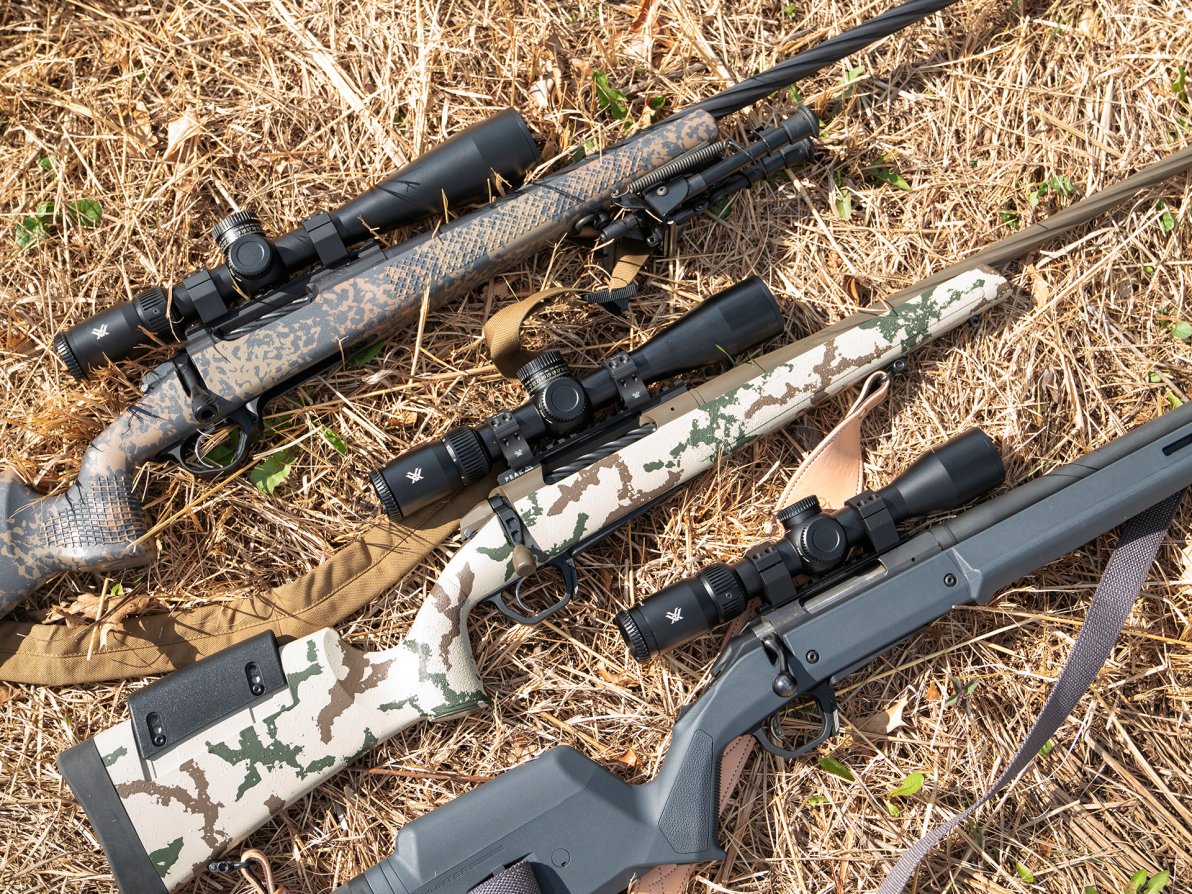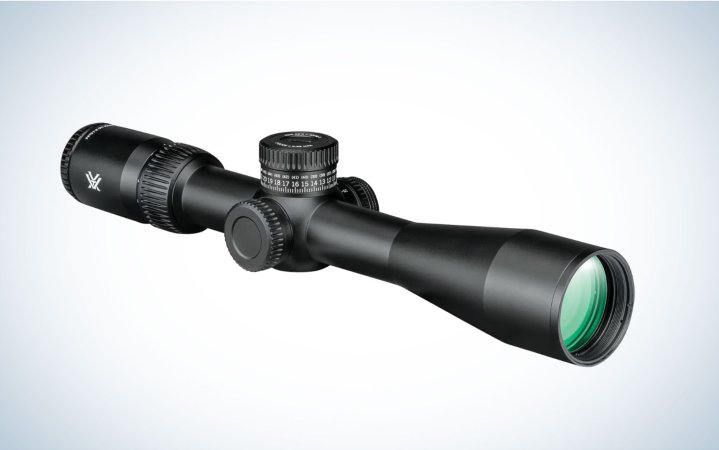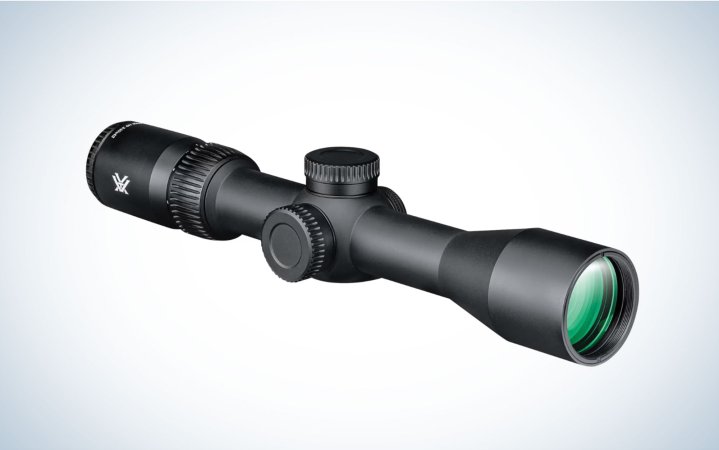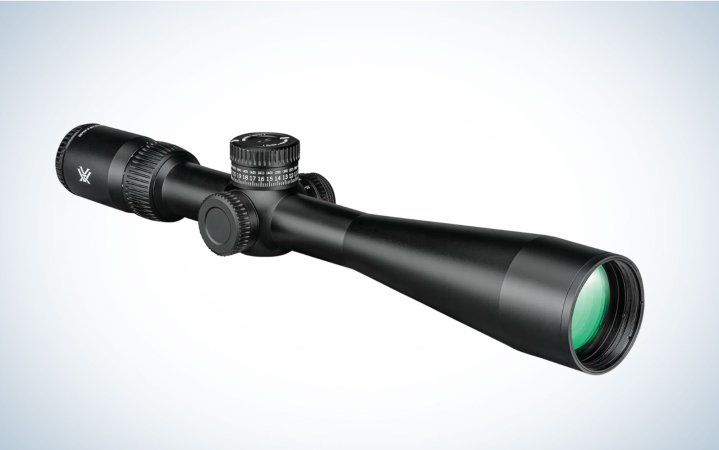We may earn revenue from the products available on this page and participate in affiliate programs. Learn More ›
This spring Vortex introduced a revamped line of Viper rifle scopes, which come in three iterations and offer a little something for all types of hunters. I figured Vortex’s Edge training facility in Wisconsin would be the ideal place to field test the new Vipers, so I threw a pre-release 3-15×44 Viper HD on my rifle and headed to their Hunter Marksmanship range outside of Madison. I had hardly set my rifle case down at the Vortex headquarters before I got the company’s customary greeting.
“Got any hunts lined up?” Corey Eliasson, Pete Schreier, and Sawyer Briel of Vortex waited for my response with rapt attention. I immediately thought about the Wyoming antelope tag I had this fall and the rig I had planned for the hunt—a Weatherby 307 in the flat-shooting 6.5 WBY RPM.
With some good training from the Vortex pros, I quickly found that my gear and my skills would be ready for speed goats this fall.
Meet The New Vortex Viper HD Scopes

Vortex has been selling the Viper line of scopes for ages, and it was time for a refresh. According to my conversation with the product team, these new models have been in the works for a few years. Compared to the previous models, the new Vipers include upgraded glass, illuminated reticles, and your choice of capped or exposed turrets and either first or second focal plane reticles. In other words, the new Vipers promise to deliver what today’s hunters and shooters expect out of a quality riflescope. In terms of price and performance, the Viper line sits between Vortex’s higher-end Razor line and more affordable Diamondback line of rifle scopes. The new Vipers are made in the Philippines.
There are three different scopes in the new line: a 2-10×42 SFP, a 3-15×44 SFP, and a 5-25×50 FFP or SFP (here’s our guide explaining FFP vs SFP).
All three options feature a 30-millimeter tube, adjustable reticle illumination, and new HD (high-definition) glass that is unique to the Viper line. Vortex says the upgrade offers a clearer view, more realistic colors, more light transmission, and better edge-to-edge sharpness than the outgoing models. Vortex also says they’re fog-proof, shock-proof, waterproof, and backed by the company’s VIP Warranty.
Reticles in these new scopes include the Dead-Hold BDC in MOA, the VMR-3 in MOA or MRAD, and the VMR-4 in MOA or MRAD. Vortex pairs magnification and reticles according to the intended applications of the scope. The same goes for capped and uncapped turrets – neither is better, it just depends on your shooting and hunting style.
While I got to test the 3-15×44 Viper, OL editor-in-chief Alex Robinson and gear editor Scott Einsmann each field tested the other two models at their home ranges.
Testing the Viper 3-15X44
Vortex Viper HD 3-15×44 SFP Specs and Features
- Magnification: 3-15x
- Objective Lens Diameter: 44 mm
- Focal Plane: Second focal plane
- Reticle: VMR-3 (MOA)
- Turrets: Exposed locking elevation, capped windage
- Tube Diameter: 30 mm
- Adjustments: 1/4 MOA
- Parallax Adjustment: 20 yards to infinity
- Maximum Elevation Adjustment: 102 MOA
- Maximum Windage Adjustment: 92 MOA
- Eye Relief: 3.4 inches
- Length: 13.2 inches
- Weight: 22.5 ounces
- MSRP: $750
The Vortex Edge instructors have seen and done it all, and they’re more than happy to share the knowledge they learned along the way. Eliasson served as a Marine Corps scout sniper and designated marksman as a defense contractor. In addition to teaching at Vortex Edge, he’s a competitive precision shooter. Schreier served as an infantryman in the Army’s 10th Mountain Division and as a police officer. Now, he competes in USPSA and teaches at Vortex Edge. Both are avid hunters.
Eliasson, Schreier, and I worked through an abbreviated version of the Vortex Edge Hunter Marksmanship course. Students who sign up for the real deal spend two full days learning about rifle setup, ballistics, marksmanship fundamentals, and real-world shooting positions.
From these guys I learned to think of my rifle, optic, and ammunition as one cohesive system that all needs to be calibrated together. I plan on hunting with 6.5 WBY RPM ammo loaded with 127-grain Barnes LRX bullets, so that’s what I brought to Vortex.
Together, we zeroed our scopes on the 100-yard indoor range. My instructors stressed building a solid position, dry firing until I felt confident, and then taking my time to make perfect shots. If your zero is not precise, every subsequent ballistic calculation will be based on faulty information.
With a good zero, we ran through some basic positional shooting at 50 yards and then we moved to an outdoor bench and walked shots out in 100-yard intervals using 10-inch steel plates to simulate a deer’s vitals. Only at 800 yards did the shifting wind finally prove too much for me to make consistent hits.
We then took to the field to engage a series of targets from unknown distances and real-world shooting positions. Eliasson mentioned that a lot of people overlook fitness and mobility when it comes to positional shooting. Yes, kneeling and sitting are useful, but can you comfortably get into position and hold still long enough to take a shot? Will joint pain or tight muscles distract you from focusing on your shot process? What will your shot placement look like after you huff and puff up a hillside? He says adding some basic exercise and stretching to your daily routine will improve positional shooting.

On a day dominated by shifty, multidirectional winds, the Viper HD 3-15×44 shined. The bright, sharp image through the new HD glass helped me pick out the movement of the short spring grass from hundreds of yards away. The reticle’s adjustable illumination works intuitively. Press once to turn it on. Press again, repeatedly, to increase brightness until it maxes out, then keep pressing repeatedly to decrease brightness. Press and hold to turn it off. The subtle illuminated dot created just the right balance of contrast for aiming precisely on shaded targets.
I’ve long been a fan of the exposed turrets Vortex uses. The Viper HD’s elevation turret pops up, provides audible and tactile clicks, and locks back in place just like the turrets on my precision rifle scope (a Vortex Strike Eagle 5-25×56 FFP). The capped windage turret takes a little bit more time to access, but it’s easy enough and you’ll likely only touch it when you zero the scope. The RevStop system is fool-proof for returning to zero after a big elevation adjustment. The windage turret uses a clever spring-loaded design where you pull the turret outward to adjust the alignment without moving the reticle itself.
I typically prefer a first-focal plane reticle, but the exposed elevation turret made dialing for elevation so easy that I grew to like the second-focal plane reticle. On longer shots, the 2-MOA subtensions made holding for wind a snap.
While the VMR-3 reticle is great for making elevation or wind holds, it’s not cut out for both at the same time. With no Christmas-tree-style holdovers, you will likely have to dial for elevation and hold for windage. So long as you have time to dial, that’s not a real problem. But if this is a deal breaker for you, opt for the Viper HD 5-25×50 with the VMR-4 reticle.
Testing the Viper HD 2-10×42
Vortex Viper 2-10X42 Specs and Features
- Magnification: 2-10x
- Objective Lens Diameter: 42 mm
- Focal Plane: Second focal plane
- Reticle: Deadhold BDC (MOA)
- Turrets: capped windage and elevation
- Tube Diameter: 30 mm
- Adjustments: 1/4 MOA
- Parallax Adjustment: 100 yards
- Maximum Elevation Adjustment: 135 MOA
- Maximum Windage Adjustment: 135 MOA
- Eye Relief: 3.4 inches
- Length: 12.1 inches
- Weight: 19.9 ounces
- MSRP: $600
This is the most traditional scope of the new Viper line, but it does include some nice modern features. The two I like the most are the illuminated reticle and the functionality of the turrets, which you simply lift and spin to reset to zero after sighting in (there’s no need to loosen tiny set screws).
The scope is simple and compact and seems like it could be the perfect optic for an all-around deer rifle, so I decided to run it through a couple field tests relevant to deer hunters. First I devised an unofficial low-light test by placing a 3D deer target 100 yards out from my backyard deck. After sunset, I focused four scopes, including the new Viper, on the target. My test subjects were:
- Bushnell Elite 4500 2.5-10X40
- Leupold VX3I 3.5-10X40
- Vortex Viper HD 2-10X42
- Leupold VX6 HD 3-18X44
I set all the scopes to 7X and then looked through each of them during fading light, paying close attention to how well I could make out the tines on the buck target. Unsurprisingly, the more affordable Leupold VX3I and Bushnell scopes (with slightly smaller objective lenses) were the first and second to drop out (respectively). While I could no longer make out detail with those two scopes, I could still count points with the Viper. About a minute and a half later the Viper winked out followed shortly by the VX6 with the larger objective lens.
The 2-10X42 Viper did outperform the more affordable scopes, as it should have, and it was also competitive with the VX6, which costs more than twice as much. In other words, it delivered low light performance as expected. It’s also worth noting that all the scopes gathered more than enough light to see the target well beyond legal shooting light.

As another informal field test, I left the Viper out during a torrential downpour. I didn’t expect the scope to take on water, but I was curious to see if the driving rain might short circuit the battery-powered illuminated reticle. I’m happy to report that it did not. After sitting in heavy rain for about an hour, the reticle worked just as it had before—no worse for the wear. There was no fog or water on the internal lenses.
The only criticism I have for the Viper I tested is that I noticed a thin scratch on one of the internal lenses (I spotted it while shining a flashlight down the tube through the objective lens). While glassing toward the setting sun I would occasionally catch a sliver of glare, which I assume was coming from the scratch. While this is not what you want to see out of a $600 scope, I actually don’t find this a deal breaker at all. Firstly because the test scope I got was a pre-production model, which tend to have some hitches. Secondly, this defect would likely be covered under the Vortex warranty, so if I were a consumer, I probably wouldn’t have to live with the scratch at all.
Ultimately, I think the 2-10X42 Viper is a solid hunting optic at a decent price. I would be more than happy to throw it on any of my deer rifles. —Alex Robinson, editor-in-chief
Testing the Viper HD 5-25×50
Vortex Viper HD 5-25×50 FFP Specs and Features
- First Focal Plane
- Reticle Options: VMR-4 MRAD (tested) or VMR-4 MOA
- 10 illumination settings
- Eye relief: 3.4 inches
- Field of view at 100 yards: 23.6 feet at 25 power and 4.7 feet at 5 power
- RevStop zerostop
- 30mm tube
- .1 MRAD or 1/4 MOA adjustments
- Max elevation: 18.9 MRAD or 68 MOA
- Travel per rotation: 10 MRAD or 25 MOA
- Parallax: 20 yards to infinity
- Weight: 25 ounces
- Price: $900
I tested the Viper HD 5-25 on my FX Impact M3, which is an air rifle that can shoot 1-inch groups at 100 yards, which is accuracy that rivals many of the best .22 rifles. I chose it as my test gun because the Viper HD 5-25 is an ideal scope for precision .22 rifles and airguns. The key feature that makes this a great rimfire scope is that the parallax adjusts from 20 yards to infinity with plenty of reference points for close range shooting. I did the bulk of my testing at 25 and 50 yards with zero issues getting a crisp image. The main issue with the parallax adjustment is that it sits right next to the knurled knob for switching on the illumination. Their proximity makes it possible to turn on the illumination when you want to adjust parallax.

Another feature that makes the Viper HD ideal for precision rimfire is its reticle. I shot a hundred pellets at a KYL rack at 25, 50, and 75 yards on a windy, prefrontal day. Whether I was holding elevation, wind, or both, the reticle gave me all the information I needed without feeling cluttered. I found the wind subtensions to be especially intuitive with small dots every .1 MIL and a bold dot every .5 MIL.
The zoom has enough tension that it won’t slip off a setting, but it’s still easy to make quick adjustments. The only thing that would make it better is adding a Switchview throw lever.
The locking elevation turret is a nice feature for preventing errant clicks. It unlocks by pulling the turret straight up, and the elevation adjustments are tactile and audible. Unfortunately the windage clicks weren’t as crisp on my test model.
I’ve used the RevStop zero stop on several Vortex scopes, including a Razor HD LHT that I took elk hunting. It’s a simple system that can be set in a few minutes. If you’re looking to push a rimfire to 300 yards, or beyond, you can remove the RevStop ring to get the most elevation out of the scope.

I’ve found the glass to be bright and clean from edge-to-edge. I could clearly make out detail on a 3D target 100 yards away 15 minutes past legal shooting light. I compared it to my Athlon Ares ETR and it held on a few minutes longer into the fading light. The Ares uses a 34mm tube and a larger objective, which makes that tight race impressive for the Viper HD.
The Viper HD 5-25×50 is about 6 ounces lighter than the Viper PST 5-25. If you add in the fact that it has a locking elevation turret and a capped windage turret, you have an excellent open-country hunting scope. —Scott Einsmann, gear editor
Final Thoughts on the New Viper HD Line
The old Viper line was a bit confusing. There were so many variants and options that shopping for a new scope could be daunting. These three new scopes cut the noise and streamline the product line, all while offering more features and better performance. Everything from the reticle selection to the turrets makes sense given.
These new Viper HD scopes are years in the making. They represent countless hours of research, development, and testing. After spending some time in the Vortex headquarters, I can’t wait to put mine into action this fall.



